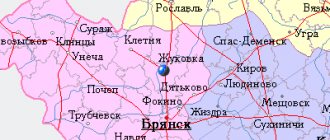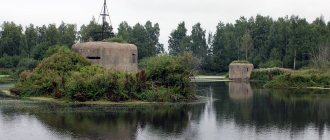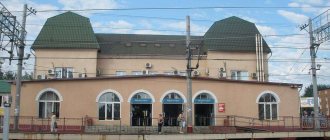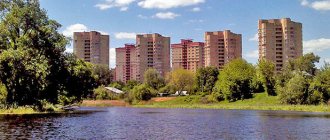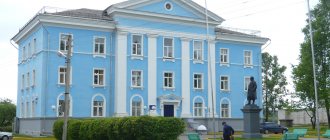- home
- >
- Advantages
- >
- Attractions
Zaoksky region is rich in interesting historical places of great cultural value. One of the most striking examples is the museum-estate of the great Russian artist V. D. Polenov
. The main building of the estate was made in a very original architectural style according to the design of the painter himself in 1892. The main purpose of the house was to serve as an art workshop. Many artists, sculptors and craftsmen work here to this day. And museum visitors can purchase unique souvenirs as souvenirs. Today the museum is one of the most famous museum-reserves in Russia.
No less famous is the museum-estate of the famous Russian scientist, writer and encyclopedist A. T. Bolotov
in Dvoryaninovo. In terms of his contribution to Russian science, he was often compared to Lomonosov. During the tour of the museum-reserve, you can swim in the estate ponds, as well as purchase souvenirs and medicinal herbs.
And in the village of Savino there is a house-museum of the hero of the Russian-Japanese War V. F. Rudnev
. Here you can get acquainted not only with the outstanding personality of the rear admiral, but also with the history of the navy. Not far from the museum building is the grave of V. F. Rudnev.
There are many ancient Orthodox churches in the Zaoksky district. In the village of Bekhovo there is the Church of the Life-Giving Trinity, built according to the design of V. D. Polenov. Also nearby is the Holy Spring at the site of the appearance of the Kazan Icon of the Mother of God, known for its healing power.
Welcome to Zaoksky district!
Polenov Museum - the pearl of the Zaoksky region
Today, the Zaoksky district is becoming more and more attractive for residents of the capital who want to buy a dacha in an ecologically clean region away from the metropolis. In connection with the expansion of Moscow, there is an increase in the cost of plots in the southern direction, along the Simferopol Highway. This trend is forcing many to take a fresh look at the so-called “distant dachas”, because 100 km from the Moscow Ring Road is just an hour’s drive without traffic jams! But in addition to the purely economic component, an important factor in the popularity of the Zaoksky district is its cultural significance
. On Zaokskaya land there are two largest museums in central Russia - the artist V.D. Polenov and agronomist A.T. Bolotova. Today we will talk about a monument of cultural heritage of national scale - the museum-reserve of Vasily Dmitrievich Polenov.
The charm of Oka
It is no coincidence that Moscow residents are so fond of the resorts and nature of the Zaoksky district. It’s really hard not to fall in love with these picturesque places! Writer Konstantin Paustovsky wrote: “Perhaps, nowhere near Moscow were there places so typically and touchingly Russian in their landscape.” The eye here makes many bends, creating unique views. And the healing air in its properties is not inferior to the resorts of Switzerland!
It is not surprising that the great Russian artist Vasily Dmitrievich Polenov
, - and he was not even a Muscovite, but a St. Petersburger, - sailing along the Oka, he exclaimed: “This is such a place, this is such freedom, and the Oka, what a beauty!” And the painter remained on the Zaoksk land forever, creating his world-famous estate on the right bank of the Oka, not far from the town of Velegozh.
Polenov's creative path
Vasily Dmitrievich Polenov is a major figure in Russian landscape painting. He was born on May 20, 1844 in St. Petersburg into a noble family. Beginning in 1863, Polenov attended the Academy of Arts, although he received his education at the faculties of physics, mathematics and law. In 1867, Polenov visited the World Art Exhibition in Paris and over the next decade constantly honed his skills in the capitals of European painting - Florence, Naples, Venice, Vienna and Munich. During the Russian-Turkish War, Vasily Polenov was an official artist under the future Emperor Alexander III.
In 1878, Polenov presented to the public perhaps his most famous painting, “Moscow Courtyard”
, which achieves literally resounding success and brings the artist truly worldwide fame.
In 1881 - 1882, Vasily Polenov went on a journey to biblical places and visited Constantinople, Palestine, Syria and Egypt. In 1882 - 1895 V.D. Polenov taught at the Moscow School of Painting, Sculpture and Architecture.
Polenovo Estate and Museum-Reserve
A real revolution in Polenov's life occurs in 1890, when he decides to purchase an estate on the banks of the Oka. Being a city dweller from birth, Polenov was very fond of the vast expanse of endless fields, dense deciduous forests descending to mighty rivers. And I always dreamed of settling in the lap of nature. In 1887, on the way to Crimea, Polenov saw the Oka from the window of a carriage and once and for all fell under the spell of this wondrous river.
“Beautiful places on the Oka near Serpukhov and beyond,” the artist wrote to his wife. “This is where we should settle.” And, a few days later, he returns to this topic: “I dreamed of a house on the banks of the Oka, how we would arrange it, how we would live there, make a large room where there would be a museum, a gallery and a library. Nearby there will be a carpentry workshop, the Admiralty, a fishery and a terrace, and above this there will be my painting workshop and your small office... Wonderful dreams, perhaps, will come true...”
Together with his student Konstantin Korovin, also a famous painter, Polenov again came to Bekhovo in May 1889: at that time, an impoverished landowner was selling a small neglected estate there. A year later, Polenov acquired this estate and built a house according to his own original design, as well as art workshops. The artist decided to name the estate “Borok”. According to Polenov’s plan, Borok was to become a “nest of artists”, and over time turn into the first provincial public museum. Polenov built a folk theater for peasants and a church in Bökhov.
Polenov took on the project of the house himself: architecture was partly an unfulfilled passion of the artist. The extraordinary abilities of Polenov as an architect were noted by I.E. Repin in his memoirs: “After all, he is an architect, and what a great one! While still a student at the Academy of Arts, he composed and edited architectural programs on a given topic for some architects, and they received medals and titles...”
Polenov's works are in striking contrast to what was generally accepted in estate architectural practice at that time, and anticipate the poetics of the Art Nouveau style in architecture. It would be more correct to call the style of Polenov’s architectural creativity “the style of different eras,” or even more precisely, the “Polenov style.”
In 1892, the Polenovsky Museum became the first art museum in a village in Russia, accessible to the widest range of visitors. Today it has the status of the state memorial historical, artistic and natural museum-reserve of Vasily Dmitrievich Polenov. Since 2011, the museum has been headed by the painter’s great-granddaughter Natalya Fedorovna Polenova. Of course, the Polenov museum-estate is a real pearl of the Zaoksky region. Go to the website of the V.D. Museum Polenova, and even better - buy a dacha on Zaokskaya land along the Simferopol highway and visit the cultural centers of the region at any time convenient for you!
Content
- 1 Church of the Life-Giving Trinity (Bekhovo)
- 2 Church of the Nativity of the Blessed Virgin Mary (Velegozh)
- 3 Church of the Intercession of the Blessed Virgin Mary (Volkovichi)
- 4 Temple of Demetrius of Rostov (Dmitrievskoye)
- 5 Temple of Michael the Archangel (Zaoksky)
- 6 Church of St. Nicholas the Wonderworker (Lighthouse)
- 7 Church of the Nativity of the Blessed Virgin Mary (Nikitino)
- 8 Temple of the Kazan Icon of the Mother of God (Savino)
- 9 Temple of the Icon of the Mother of God “The Sign” (Strakhovo)
- 10 Temple of Alexander the Roman (Chentsovo)
Bolotov's estate - the pride of Zaokskaya land
A.S. Pushkin, trying to show the enlightenment of his Onegin, said about him: “But I read Adam Smith and was a deep economist.” Andrey Timofeevich Bolotov
I also knew the Scottish economist as an older contemporary (in 1797 Bolotov was elected an honorary member of the Royal Saxon Leipzig Economic Society).
And in managing the farm he proved himself to be an equally experienced manager. However, the main merit of A.T. Bolotov became agronomy and botany
, in which he achieved great success and contributed to contemporary science! It is believed that it was Bolotov who had the greatest influence on tomatoes and potatoes being recognized as the popular agricultural crops that they are now, but which they were not yet in the 18th century...
Andrei Timofeevich was born on October 18, 1738 - very soon he will turn 280 years old! In less than a century of life - he did not live only two days before his 95th birthday - Bolotov established himself as the largest writer of his time, memoirist, moral philosopher and, of course, an agronomist.
Bolotov was born on his family estate Dvoryaninov
, which to this day is the real pride of the Zaokskaya land. Until the age of 12, the future scientist lived with his father Timofey Petrovich, who taught his son foreign languages, mathematics and geography. Subsequently, young Bolotov was sent to study with a Frenchman in St. Petersburg. At the age of 19, young Andrei Bolotov entered the service with the rank of second lieutenant and went to the Seven Years' War. In 1757 he went on guard duty in Königsberg, present-day Kaliningrad. There he became a translator and clerk under generals N.A. Korfe and V.I. Suvorov, who ruled the Kingdom of Königsberg.
In his free time from service, Andrei Timofeevich Bolotov continued his education and took lessons from professors at the University of Koenigsberg. Upon his return to Russia, Bolotov retired with the rank of captain and returned to his native Dvoryaninovo, where he devoted himself entirely to science. In his village, Bolotov began studying agriculture
, and along the way he published works on
moral philosophy and pedagogy
.
For a whole decade, from 1780 to 1790, A.T. Bolotov collaborated with N.I. Moskovskie Vedomosti. Novikova. In this magazine, Andrei Timofeevich published articles, the number of which by the end reached 4 thousand! Or - 40 separate volumes of an entire encyclopedia! Bolotov himself entitled this colossal publication as “a collection of all kinds of economic news, experiences, discoveries, notes, instructions, notes and advice related to agriculture, cattle breeding, gardens and orchards, meadows, forests, ponds, various products, village buildings, homemade medicines, medicinal herbs and all sorts of things necessary and inevitable for city and village residents.”
Bolotov lived almost continuously for decades in Dvoryaninov and here, in 1833, he found eternal peace. Andrei Timofeevich was buried in the cemetery of the village of Rusyatino in the Zaoksky district of the Tula region, two kilometers from Dvoryaninov. Bolotov's grave has survived to this day.
Church of the Life-Giving Trinity (Bekhovo)[edit]
The Church of the Life-Giving Trinity was built from 1904 to 1906.
In May 1918, a museum was created in Polenov’s estate, declared a national treasure of the republic.
The temple was closed in 1934. The bells were removed, property was looted, and the stone fence was dismantled.
In the autumn of 1941, when the front line passed through Polenovo and Bekhovo, the church was badly damaged.
In 1965, it was taken under protection as an architectural monument; since 1972, restoration work has been carried out on it. Since 1985, the building has housed an exhibition hall.
The temple was returned to believers in 1989. Divine services began in the 1990s.
Address:
Tula region, Zaoksky district, Bekhovo village.
Zaoksky district (Tula region)
- Azarovka
- Alexandrovka
- Aleshkovo
- Antonovka
- Recreation Base Metallurg
- Barantsevo
- Berezovka
- Behovo
- Bogorodskoye
- Boldovo
- Bolotovo
- Butikovo
- Bykovka
- Velegozh
- Venyukovo
- Venyukovo
- Verkhneye Apasovo
- Verkhnee Romanovo
- Veselevo
- Cherries
- Volkovichi
- Voronovo
- Fiction
- Galkino
- Gatnitsa
- Gibkino
- Gorki
- Gorokhovo
- Davydovskoe
- Dvoryaninovo
- Dmitrievskoe
- Holiday House Velegozh
- Domnino
- Domninskie Dvory
- Dyatlovo
- Zhdamirovo
- Zhdamirovsky
- Iron
- Zanino
- Zaoksky
- Zlobino
- Zolotikha
- Ivanovskoe
- Ignatovo
- Iskan
- Kaledinovka
- Kamenka
- Karpishchevo
- Kineevo
- Klimovka
- Klishchino
- Kozlovka
- Konyushino
- Kortnevo
- Kostino
- Koshkino
- Kryukovo
- Laptevo
- Lesnovka
- Lyubicki
- Malakhovo
- Matyushino
- Lighthouse
- Mirotinsky
- Mitino
- Molchanovo
- Mosolovo
- Mukhanovka
- Little mice
- Naspischi
- Nedyakovo
- Nemtsovo
- Nenashevo
- Nechaevo
- Nechaevskie Vyselki
- Nechaevskoye Forestry
- Nizhnee Romanovo
- Nizhnyaya Gorodnya
- Nikitino
- Nikolskoye
- Nikonovka
- Nikulino
- New Village
- Novoselki
- Ostretsovo
- Pankino
- Parshino
- Pakhomovo
- Pakhomovo
- Pakhomovo
- Pashkovo
- Petrishchevo
- Pirogovo
- Povalyaevo
- Pokrovskoye
- Polenovo
- Prioksky
- Prokshino
- Pynino
- Rozhdestveno
- Romankovo
- Rusyatino
- Ryazanovo
- Savino
- Sanino
- Svinskaya
- Senino
- Simonovo
- Skripovo
- Sonino
- Pine
- station Priokskaya
- st Shulgino
- Insurance
- Icy
- Sumarokovo
- Sukhotino
- Taidakovo
- Tatar Farms
- Tatar
- Temyansky
- Temyan
- Terekhovo
- Teryaevo 1st
- Teryaevo 2nd
- Grouse
- Turino
- Tourist complex Velegozh
- Tyapkino
- Uspensky
- Ushakovka
- Fedino
- Filatovo
- Filimonovka
- Khvoroshchino
- Khlebodarovka
- Khripkovo
- Khripkovskie Vyselki
- Khrushchevo
- Chegodaevo
- Chentsovo
- Shaleevo
- Shevernevo
- Shevernyaevo
- Shegostovo
- Shulgino
- Shulginsky
- Shcheblovo
- Shchepotyevo
- Yakovlevo
- Yakovlevsky
- Yaroslavtsevo
Village
Rural settlement Malakhovskoye
Village
Rural settlement Demidovskoye
Village
Rural settlement Strakhovskoye
Village
Rural settlement Strakhovskoye
Locality
Rural settlement Strakhovskoye
Village
Rural settlement Demidovskoye
Village
Rural settlement Demidovskoye
Village
Rural settlement Strakhovskoye
Village
Rural settlement Demidovskoye
Village
Rural settlement Demidovskoye
Village
Rural settlement Malakhovskoye
Village
Rural settlement Strakhovskoye
Village
Rural settlement Demidovskoye
Village
Rural settlement Strakhovskoye
Village
Rural settlement Demidovskoye
Village
Rural settlement Demidovskoye
Village
Rural settlement Demidovskoye
Village
Rural settlement Malakhovskoye
Village
Rural settlement Strakhovskoye
Village
Rural settlement Malakhovskoye
Village
Rural settlement Strakhovskoye
Village
Rural settlement Demidovskoye
Village
Rural settlement Strakhovskoye
Village
Rural settlement Malakhovskoye
Village
Rural settlement Demidovskoye
Village
Rural settlement Malakhovskoye
Village
Rural settlement Strakhovskoye
Village
Rural settlement Demidovskoye
Village
Rural settlement Demidovskoye
Village
Rural settlement Malakhovskoye
Village
Rural settlement Demidovskoye
Locality
Rural settlement Strakhovskoye
Village
Rural settlement Demidovskoye
Village
Rural settlement Demidovskoye
Village
Rural settlement Malakhovskoye
Village
Rural settlement Strakhovskoye
Village
Rural settlement Strakhovskoye
Village
Rural settlement Demidovskoye
Village
Rural settlement Demidovskoye
Settlement
Urban settlement Work settlement Zaoksky
Village
Rural settlement Malakhovskoye
Village
Rural settlement Demidovskoye
Village
Rural settlement Demidovskoye
Village
Rural settlement Demidovskoye
Village
Rural settlement Strakhovskoye
Village
Rural settlement Demidovskoye
Village
Rural settlement Demidovskoye
Village
Rural settlement Malakhovskoye
Village
Rural settlement Demidovskoye
Village
Rural settlement Demidovskoye
Village
Rural settlement Demidovskoye
Village
Rural settlement Demidovskoye
Village
Rural settlement Strakhovskoye
Village
Rural settlement Demidovskoye
Village
Rural settlement Malakhovskoye
Village
Rural settlement Strakhovskoye
Village
Rural settlement Malakhovskoye
Village
Rural settlement Demidovskoye
Village
Rural settlement Demidovskoye
Village
Rural settlement Demidovskoye
Village
Rural settlement Malakhovskoye
Village
Rural settlement Malakhovskoye
Village
Rural settlement Malakhovskoye
Village
Rural settlement Demidovskoye
Village
Rural settlement Strakhovskoye
Village
Rural settlement Demidovskoye
Village
Rural settlement Strakhovskoye
Village
Rural settlement Demidovskoye
Village
Rural settlement Malakhovskoye
Village
Rural settlement Strakhovskoye
Village
Rural settlement Demidovskoye
Village
Rural settlement Demidovskoye
Village
Rural settlement Demidovskoye
Village
Rural settlement Strakhovskoye
Village
Rural settlement Strakhovskoye
Village
Urban settlement Work settlement Zaoksky
Village
Rural settlement Malakhovskoye
Village
Rural settlement Malakhovskoye
Village
Rural settlement Demidovskoye
Village
Urban settlement Work settlement Zaoksky
Village
Rural settlement Demidovskoye
Village
Rural settlement Demidovskoye
Village
Rural settlement Malakhovskoye
Village
Rural settlement Malakhovskoye
Village
Rural settlement Demidovskoye
Village
Rural settlement Malakhovskoye
Village
Rural settlement Malakhovskoye
Village
Rural settlement Demidovskoye
Railroad station
Rural settlement Demidovskoye
Village
Rural settlement Demidovskoye
Village
Rural settlement Strakhovskoye
Village
Rural settlement Strakhovskoye
Village
Rural settlement Demidovskoye
Village
Rural settlement Strakhovskoye
Village
Rural settlement Malakhovskoye
Village
Rural settlement Strakhovskoye
Village
Rural settlement Malakhovskoye
Village
Rural settlement Malakhovskoye
Village
Rural settlement Demidovskoye
Village
Rural settlement Malakhovskoye
Village
Rural settlement Demidovskoye
Village
Rural settlement Malakhovskoye
Village
Rural settlement Strakhovskoye
Village
Rural settlement Malakhovskoye
Village
Rural settlement Demidovskoye
Village
Rural settlement Malakhovskoye
Village
Rural settlement Malakhovskoye
Village
Rural settlement Demidovskoye
Village
Rural settlement Strakhovskoye
Village
Rural settlement Demidovskoye
Village
Rural settlement Malakhovskoye
Railroad station
Rural settlement Malakhovskoye
Railroad station
Rural settlement Demidovskoye
Village
Rural settlement Strakhovskoye
Village
Rural settlement Demidovskoye
Village
Rural settlement Demidovskoye
Village
Rural settlement Demidovskoye
Village
Rural settlement Strakhovskoye
Village
Urban settlement Work settlement Zaoksky
Village
Rural settlement Demidovskoye
Village
Rural settlement Strakhovskoye
Village
Rural settlement Strakhovskoye
Village
Rural settlement Malakhovskoye
Village
Rural settlement Demidovskoye
Village
Rural settlement Demidovskoye
Village
Rural settlement Strakhovskoye
Village
Rural settlement Demidovskoye
Locality
Rural settlement Strakhovskoye
Village
Rural settlement Strakhovskoye
Village
Rural settlement Strakhovskoye
Village
Rural settlement Demidovskoye
Village
Rural settlement Malakhovskoye
Village
Rural settlement Demidovskoye
Village
Rural settlement Demidovskoye
Village
Rural settlement Demidovskoye
Village
Rural settlement Demidovskoye
Village
Rural settlement Strakhovskoye
Village
Rural settlement Strakhovskoye
Village
Rural settlement Demidovskoye
Village
Rural settlement Malakhovskoye
Village
Rural settlement Malakhovskoye
Village
Rural settlement Demidovskoye
Village
Rural settlement Strakhovskoye
Village
Rural settlement Demidovskoye
Village
Rural settlement Demidovskoye
Village
Rural settlement Demidovskoye
Village
Rural settlement Demidovskoye
Village
Rural settlement Demidovskoye
Village
Rural settlement Demidovskoye
Village
Rural settlement Malakhovskoye
Village
Rural settlement Malakhovskoye
Village
Rural settlement Malakhovskoye
www.bankgorodov.ru
Church of the Intercession of the Blessed Virgin Mary (Volkovichi)[edit]
The Intercession stone church was built in 1902 at the expense of parishioners and benefactors on the site of a dilapidated wooden church.
By 1916 there was a parochial school in the village.
The temple was closed in the 1930s, and a granary was installed in the building.
In the 1950s, the bell tower was destroyed, the building was abandoned and collapsed.
The temple was returned to believers in 1998.
Divine services and restoration began in 1999.
Address:
Tula region, Zaoksky district, Volkovichi village.
Church of the Nativity of the Blessed Virgin Mary (Velegozh)[edit]
The temple was built in 1731 at the request of Prince Ivan Trubetskoy on the site of a burnt wooden church. A rare example of Anninsky Baroque
During the Great Patriotic War, the front line passed along the Oka River, Velegozh was shot through, and shells hit the temple.
In 1961, the temple was closed and destroyed, the building was destroyed.
In 1991, it was returned to believers, and restoration work began.
Address:
Tula region, Zaoksky district, village of Velegozh
Top 5 most beautiful places in the Tula region
I have always been interested in the question: why does it seem to us that somewhere in a foreign land is necessarily more interesting and beautiful, and the grass is greener, and the sky is bluer. And often we don’t notice all this right under our noses. I have long wanted to share places that for me are some of the most beautiful and picturesque in our region. If it is not possible to go on long journeys, there is always a great alternative to spend time close to home and discover, of course, not America, but at least the amazing places of the Tula region. And believe me, there is something to marvel at here. So, I present to you the Top 5 most beautiful places in the Tula region, amazing natural attractions.
In the vicinity of the Oka River
For some, “the Volga River flows...”, but for us, the Oka. It is not for nothing that artists and poets found inspiration on the banks of this river. We also love to be inspired by beautiful views, so every year we go for fresh air and river landscapes near the city of Aleksin, Tula region.
Among the pines there are many sanatoriums, recreation centers, and boarding houses, but we are looking for more secluded corners.
True, a surprise awaited us last summer. The people decided to “privatize” part of the coast by erecting barriers,
some kind of huts,
indicating that this place is occupied (and for a long time).
Our surprise knew no bounds at such agility. But when you go ashore the Oka, you forget about everything and enjoy immersing yourself in the surrounding atmosphere.
And this is a picture truly worthy of an artist’s brush.
In the foggy dawn, the fishermen are already at the starting point.
Although the fish caught here are not particularly large. But, what excitement.
Fathers, who is this?
So much luck! We were lucky to meet a red-haired guest who was watching the crane with a hunting gleam in her eyes.
A great place to gain strength, breathe deeply and be inspired for new adventures!
Quarries in the Suvorovsky district
The Suvorovsky district at one time was quite rich in mineral resources. In the vicinity of the city of Suvorov, everything was mined. But, as usual, over time everything stopped, and we inherited a changed landscape with many beautiful lakes.
These lakes at one time became a real discovery for us. Clay was mined in the quarry, and, apparently, thanks to it, the water in the lake has a bizarre blue color.
A sort of paradise in our latitudes.
But the “range” of Suvorov quarries does not end there. We start from the lake-moon.
We climb to the very top.
And here: “My area: all journeys begin here!”
It’s truly not immediately clear where you find yourself.
A series of mountains, canyons and lakes replace each other.
The dead forest in the middle of the lake adds even more mystery to this place.
And the local sand is incredibly beautiful. From bright yellow
to soft pink.
We have not yet explored all corners of these places. So, I am sure that new discoveries await us ahead.
Ishutinskoye settlement
I want to sing the most laudatory odes to this river. Fast, impetuous, beautiful. By the way, that’s what it’s called – Beautiful Sword. The very name of the river is shrouded in many legends and traditions. They are mainly connected with a sword that was once lost in the fast waters of a river... But who lost it remains a mystery, because... versions on this matter vary. The beautiful Mecha is surprisingly picturesque in itself, but on the high and steep banks of this river, which meanders in bizarre bends, you can find the site of ancient settlements, Tula Switzerland, ancient megaliths. We go to the Efremovsky district of the Tula region to the Ishutinskoye settlement. The path is not close, it is about 180 kilometers from Tula, and at the entrance to the settlement it is along a dirt road.
What kind of legends has this place become overgrown with: there was a city here, and people mysteriously disappeared and reappeared during the Tatar raids, and where it all went is unknown. But we love such mysteries, they only fuel interest and the desire to embark on a historical excursion. And here is the first of them. The famous ancient cliff in profile looks like... Pushkin.
Here is such a miraculous monument to the great poet. A true marvelous wonder.
And when you climb the cliff itself, a fabulous panorama will open before you.
It is in this place that the Beautiful Sword makes smooth bends with many rapids and riffles. Vacationers really enjoy this natural jacuzzi.
But the river never tires of showing its violent temper. The current is quite strong and the bottom is very rocky.
In some places the water boils with violent force.
But fishermen are hoping for a catch here too.
And we say goodbye to the sun and draw fantastic fiery figures.
Tula Switzerland and Horse-Stone
This place in the village of Krasnogorye, all in the same Efremovsky district, has rightfully been called Tula Switzerland for a long time. The amazing picturesqueness of the high banks of the Beautiful Sword, forests, hillocks and hills - everything simply fascinates with its natural beauty.
There is also mysticism and legends here. On the edge of the village on a high hill, fancy stones are scattered everywhere. Their shape is unusual; many generally resemble the frozen skulls of the ancient inhabitants of the earth.
In addition, in pre-revolutionary times this village was called Vedmino. It sounds very symbolic, looking at all these stone piles.
Ancient megaliths are a real miracle in the Tula region. But the most amazing thing is the views that open over the surrounding area. It’s especially great to come here in the summer, when the lush green grass, forest and huge strawberry meadow will simply enchant and bewitch you.
There was once a water mill on this site.
And there in the distance you can see a temple.
Very close to “Switzerland” in the village of Kozye there is the most famous megalith in our area - the Horse-Stone.
A huge twenty-ton block, as if on a pedestal, stands on three smaller boulders.
Naturally, there are many legends about the origin of the Horse-Stone. Most of all, I like the story of a hero who died in an unequal battle, and his faithful horse turned to stone from grief. But most legends have pagan roots, which is not surprising. Let's remember the famous Sin-kamen (Blue Stone) on Lake Pleshcheyevo. Maybe on the banks of the Beautiful Sword in ancient times, rituals were held or there was an ancient temple. Mysteries that excite the imagination, but the truth will remain a mystery for us, covered in darkness. The belief has been preserved that the Horse-Stone has miraculous powers. A man who sits on this stone will become “like a stallion,” and a woman will be able to conceive a child. In such places, I especially feel the connection of times, pride in our Russian land. You stand up on a pebble and take a look. What vast expanses all around!
Quarries in the village of Konduki
Everyone has their own sources of inspiration. For me it's the mountains and the sea.
Therefore, I found an analogue for myself in the Tula region, a kind of joint creativity of man and nature. Mind-blowing quarries in the Uzlovsky district in the village of Konduki.
Many will probably be surprised why this place is No. 1 in my TOP 5, but it is this place that never ceases to amaze me with its unsurpassed picturesqueness every visit. Why not mountains?
At one time there were coal mines here, so the quarry area is simply huge. After the closure of the mines, the area gradually began to acquire the features of a lake region.
Here you dissolve in the surrounding beauty, and constantly feel a slight sense of dizziness, like when you fell in love for the first time. The surface of the lakes is of amazing color, and of different shades.
And these intricately rugged hills resemble Martian landscapes.
An unrealistically beautiful place where your heart skips a beat and the feeling of unity with nature never leaves you!
Surely there are many more such places in the Tula region. I will be glad if the list is expanded.
Top 5 most beautiful places in the Tula region on the map
Subscribe to the news!
galina-lukas.ru

